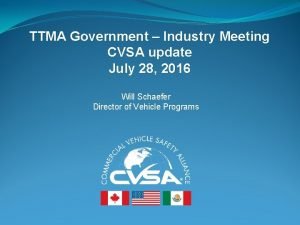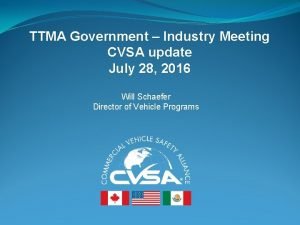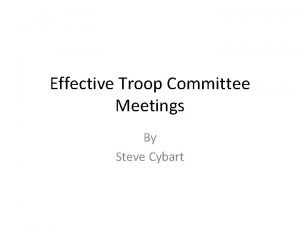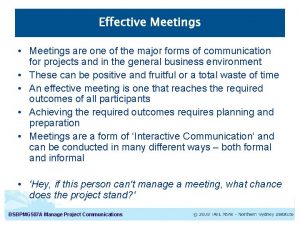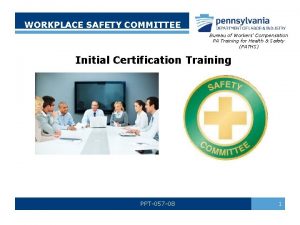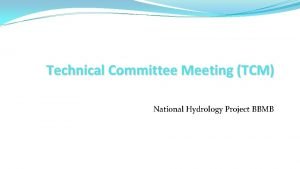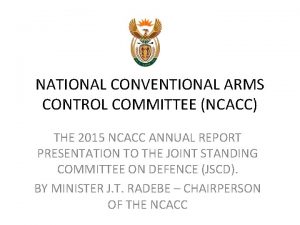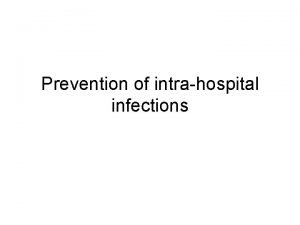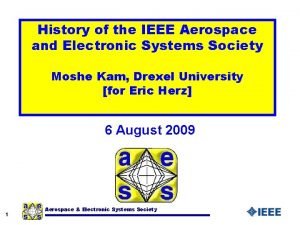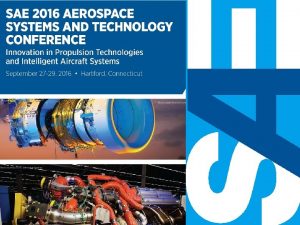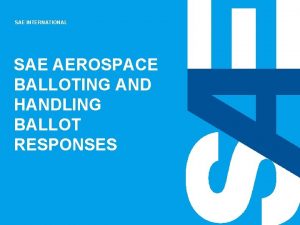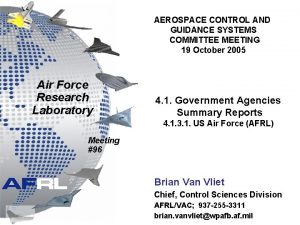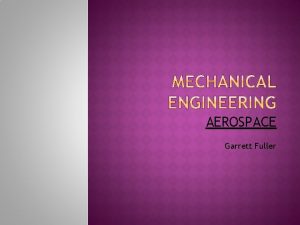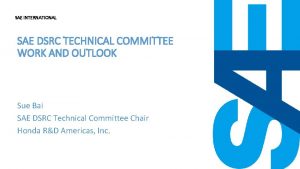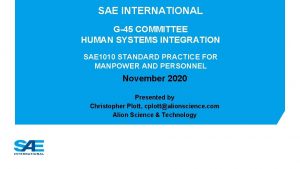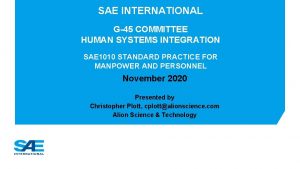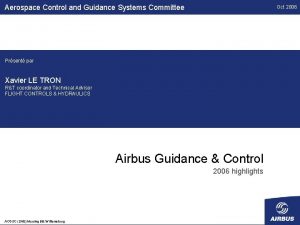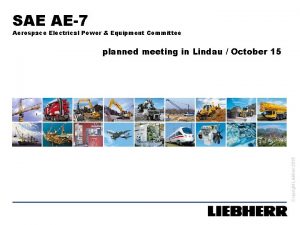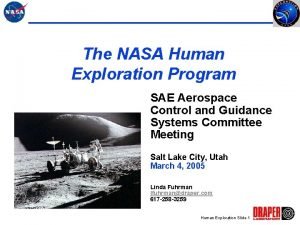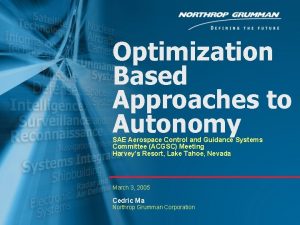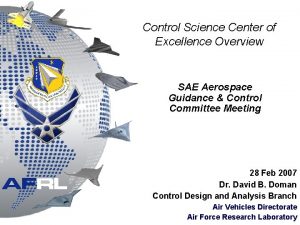SAE Aerospace Control and Guidance Committee Meeting No















- Slides: 15

SAE Aerospace Control and Guidance Committee Meeting No. 96 Hilton Head SC Oct. 19 -21, 2005 Ron Hess Dept. of Mechanical and Aeronautical Engineering University of California Davis, CA

Outline • A simplified technique for modeling piloted rotorcraft operations near ships • A simplified approach for modeling pilot pursuit control behavior in multi-loop flight tasks • Certification and design issues for rudder control systems in transport aircraft • Nonlinear inversion control for a ducted fan UAV • Design, construction and testing of a UAV for remote sensing

A Simplified Technique for Modeling Piloted Rotorcraft Operations Near Ships Research supported by Phase II SBIR to Robert Heffley Engineering: Pilot Behavioral Modeling for Flight Operations Near Ships; Naval Air Warfare Center, Patuxent River, MD

A Simplified Technique for Modeling Piloted Rotorcraft Operations Near Ships • Aircraft shipboard operations, fixed or rotary wing, can be potentially hazardous to personnel in the vehicle and on the flight deck • Determining suitability of proposed flight control systems for shipboard operations through analysis and computer simulation is an important, if not critical design challenge • Computational requirements for high-fidelity modeling of the near-ship environment may inhibit its use as a preliminary assessment tool for the flight control/handling qualities engineer • Simplified approaches to this complex modeling problem may be useful

A Simplified Technique for Modeling Piloted Rotorcraft Operations Near Ships • Ship motion from closed-form expressions • Atmospheric turbulence modeling from scaled METS (Mixer. Equivalent Turbulence Simulation) • Pilot model selection • Handling qualities level prediction • AIAA Paper No. 2005 -6030, AIAA Atmospheric Flight Mechanics Conference and Exhibit, San Francisco, CA 15 -18 August, 2005

A simplified approach for modeling pilot pursuit control behavior in multi-loop flight tasks Research supported by Phase II SBIR to Robert Heffley Engineering: Pilot Behavioral Modeling for Flight Operations Near Ships; Naval Air Warfare Center, Patuxent River, MD

A simplified approach for modeling pilot pursuit control behavior in multi-loop flight tasks .

A simplified approach for modeling pilot pursuit control behavior in multi-loop flight tasks Hover repositioning task UCE = 1 . UCE = 3

Certification and design issues for rudder control systems in transport aircraft Research Supported by: FAA Hughes Research Center; Certification Standards for Transport Aircraft From NTSB recommendations regarding AA 587 accident • Modify FAR Part 25 standards to include a certification standard that will ensure safe handing qualities in the yaw axis throughout the flight envelope, including limits for rudder pedal sensitivity. • After certification standard established, review designs of existing airplanes to determine if they meet the standard…determine if the airplanes would be adequately protected from the adverse effects of potential aircraft-pilot coupling (APC) after rudder inputs at all airspeeds.

Certification and design issues for rudder control systems in transport aircraft Rudder Pedal Force/Feel System Characteristics

Certification and design issues for rudder control systems in transport aircraft Pilot modeling results System A highly nonlinear force/feel System B more linear force/feel AIAA Paper No. 2005 -6035, AIAA Atmospheric Flight Mechanics Conference and Exhibit, San Francisco, CA 15 -18 August, 2005

Nonlinear inversion control for a ducted fan UAV Research Supported by: Army Aeroflightdyamamics Directorate, NASA Ames; MS Student: Christina Spaulding (MS 2005) NASA lead researchers: Dr. Mark Tischler, Mohammadreza Mansur, Dr. Jack Franklin Nonlinear aero model of 29 inch diameter UAV

Nonlinear inversion control for a ducted fan UAV CONDUIT used for outer-loop design

Nonlinear inversion control for a ducted fan UAV Velocity command-following performance AIAA Paper No. 2005 -6231, AIAA Atmospheric Flight Mechanics Conference and Exhibit, San Francisco, CA 15 -18 August, 2005

Design, construction and testing of a UAV for remote sensing Research Supported by: University of California, California Space Institute (Two year grant) • Participants: J. J. Chattot (Team Lead) R. Davis (Propulsion) M. Hafez (Aerodynamics) R. Hess (Guidance and Control) S. Joshi (Guidance and Control) V. La Saponara (Structures) C. van Dam (Aerodynamics/Performance) • Design just getting underway
 Factors affecting balanced occlusion
Factors affecting balanced occlusion Indirect guidance
Indirect guidance Sae government industry meeting 2019
Sae government industry meeting 2019 Sae government industry meeting 2019
Sae government industry meeting 2019 What is meeting and types of meeting
What is meeting and types of meeting What is meeting and types of meeting
What is meeting and types of meeting Bsa committee meeting agenda
Bsa committee meeting agenda Steering committee meeting agenda sample
Steering committee meeting agenda sample Safety committee meeting ppt
Safety committee meeting ppt Tcm technical committee meeting
Tcm technical committee meeting Excavator control levers
Excavator control levers For today's meeting
For today's meeting Proposal kickoff meeting agenda
Proposal kickoff meeting agenda National conventional arms control committee
National conventional arms control committee Infection control committee
Infection control committee Ieee transactions on aerospace and electronic systems
Ieee transactions on aerospace and electronic systems


